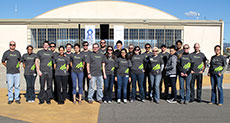Solar Decathlon 2013
Arizona State University and The University of New Mexico
For the U.S. Department of Energy Solar Decathlon 2013, Arizona State University and The University of New Mexico designed a house that celebrates its unique equilibrium with the desert environment. SHADE (Solar Homes Adapting for Desert Equilibrium) is intended to grow and adapt with its users by creating microclimates that mediate between the landscape and the interior environment. With independent modules that can be combined in various configurations and a prominent solar canopy that provides a shaded outdoor extension of the house, SHADE is built for a community-oriented, indoor-outdoor lifestyle.
Design Philosophy
SHADE pays tribute to the interdependence of desert plant life while maximizing occupant comfort and flexibility. Solar energy, regionally proven passive heating and cooling, and intensive water management nurture a healthy and sustainable habitat, and flexible, modular spaces foster a broader community concept.
Features
- Screens on the walls provide cooling shade and a still boundary layer of air, mimicking the needles on the saguaro cactus, which perform similar functions.
- Fiber-cement board highlights the material warmth of the wooden shade structure as it reflects the Southwestern sunsets.
- Tanks store collected rainwater, which is used to irrigate the landscape.
- Rain screens grow native species of flowering vine and bougainvillea and provide a climate barrier.
- Modular furniture enables the flexible room space to be configured as a kitchen, dining room, living room, bedroom, or office.
- Natural clay coating the interior walls provides a humidity buffer.
Technologies
- The independent solar canopy is composed of 36 high-efficiency mono-crystalline photovoltaic panels.
- Phase-change material distributed throughout the house stores thermal energy and buffers temperature fluctuations by redistributing the energy as passive heating and cooling.
- The capillary radiant system in the ceiling, working with the phase-change materials in the floors, passively charges at night while the ceiling mechanics shift the peak load.
- A thermal battery in the mechanical room concentrates low temperatures at night and then slowly thaws ice to cool the space during the day in an adaptation of commercial-scale ice storage systems.
- A whole-house system controls the energy systems and monitors the efficiency of the solar panels.
Market Strategy
Designed with active retirees in mind, this house seeks to provide balanced, sustainable living in the natural habitat while maximizing ease of use and comfort. Reconfigurable elements allow the space to adjust to changing living styles and can be combined with existing homes to create flexible living communities.
What's Next
After the Solar Decathlon, SHADE will be reassembled at a solar housing community in Albuquerque, New Mexico, called Mesa Del Sol. There, further research will be conducted on smart‐grid integration and the radiant/thermal storage and controls systems. The house will also be open for occasional public exhibits for education and outreach. SHADE will remain at Mesa del Sol through March 2014.
In April, SHADE will travel to Phoenix to be exhibited as part of PHX Renews, a partnership of Keep Phoenix Beautiful, the City of Phoenix, and Barron Collier Companies. There, the Arizona Science Center will program the house for public exhibit in its new home. In addition, Arizona State University students from The Design School and the School of Sustainable Engineering and the Built Environment will study the performance of the building and landscape systems.
Contact
Alia Taqi
Phone: 301-919-9108
 Enlarge image
Enlarge image
The Arizona State University and The University of New Mexico Solar Decathlon 2013 team (Courtesy of the Arizona State University and The University of New Mexico Solar Decathlon 2013 team)
The Arizona State University and The University of New Mexico audiovisual presentation
Team Deliverables
Neither the United States, nor the Department of Energy, nor the Alliance for Sustainable Energy LLC, nor any of their contractors, subcontractors, or their employees make any warranty, express or implied, or assume any legal liability or responsibility for the accuracy, completeness, or usefulness for any purpose of any technical resources or data attached or otherwise presented here as reference material.



